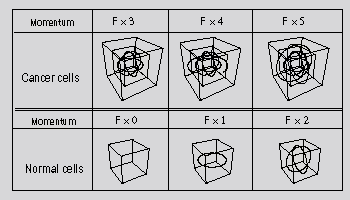|
3. Theoretical Models of Normal and Cancer Cells
Now, let us make theoretical models of two kinds of cells: a normal and a cancer cell. In the previous two sections, we can obtain two different points between a normal and a cancer cell. First, although a normal cell does not have three-dimensional movement, a cancer cell has it. Second, a cancer cell contains a large amount of momentum compared with a normal cell. These two indications enable us to make theoretical models of normal and cancer cells as shown in the figure below.

Next, consider in detail why we can make the theoretical models as shown in the figures above. In nature, movement having three-dimensional stability is only three-dimensional one. This leads us to indicate as follows: "a normal cell does not have three-dimensional stability, so that it contains movement controlled by one or two-dimensional movement; on the other hand, a cancer cell has three-dimensional stability, so that it contains movement controlled by three-dimensional movement." Furthermore, a normal cell transforms itself into a cancer cell by keeping its original cellular character; for instance, a hepatocyte transforms itself into a hepatocellular cancer cell. This fact also leads us as followings. When a normal cell containing movement controlled by one-dimensional movement transforms itself into a cancer cell, it will transform itself into a cancer cell containing movement controlled by one and three-dimensional movement. Furthermore, when a normal cell containing movement controlled by two-dimensional movement transforms itself into a cancer cell, it will transform itself into a cancer cell containing movement controlled by two and three-dimensional movement. All in all, these reasons allows us to make the theoretical models as shown in the figures above.
• Relationship between Normal and Cancer Cells
A normal and a cancer cell differ in level; specifically, a cancer cell can be considered to belong to a level next higher than that of a normal cell. This phenomenon can be deduced from different kinds of atoms. Atoms can be classified into different groups according to their shells. For example, helium has a shell (K-shell); neon has two shells (K and L-shell). Thus, we can say that neon belongs to a level next higher than that of helium. Likewise, a normal and a cancer cell, as shown in the figures above, can be considered to have a shell and two shells respectively, so that it can be concluded that a cancer cell belongs to a level next higher than that of a normal cell. That is, a cell and an atom resemble each other in system. |